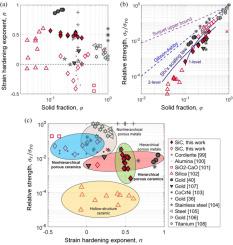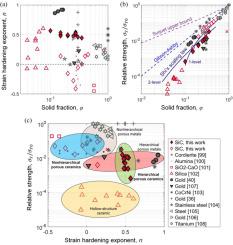基于分层纳米孔的应变硬化韧性陶瓷设计策略
IF 12.8
1区 材料科学
Q1 ENGINEERING, MECHANICAL
引用次数: 0
摘要
克服陶瓷固有的脆性是材料科学与工程中一个长期未解决的难题。在这里,我们展示了一种新的有效策略,通过引入分层spinodal结构来实现陶瓷的脆性-韧性转变。结合相场法和分子动力学(MD)方法,我们首次采用相场法分别构建了1级和2级结构的纳米多孔SiC样品,其合理性得到了很好的验证,具有spinodal拓扑结构。然后,采用全原子MD模拟方法研究了纳米孔陶瓷在压缩条件下的力学响应,揭示了纳米尺度下的变形机制。结果表明:1级纳米多孔碳化硅样品由于应力集中引起的裂纹表现为常规脆性;与此形成鲜明对比的是,层次化的2级样品表现出延展性、应变硬化、类金属的行为,这是由于层错等缺陷的分散核的存在,有效地分散了应力,防止了应力集中引起的破坏。分层纳米多孔陶瓷的强度遵循施定律,而不是经典的吉布森-阿什比定律。我们的研究不仅阐明了两种不同的变形机制,而且还引入了一种高效的分层纳米多孔策略,用于设计具有优异应变硬化能力的韧性陶瓷,解决了陶瓷脆性的长期挑战。本文章由计算机程序翻译,如有差异,请以英文原文为准。


Hierarchical nanoporous-based design strategy towards ductile ceramics with excellent strain hardening capability
Overcoming the inherent brittleness of ceramics is a longstanding, unsolved challenge in materials science and engineering. Here, we demonstrate a new effective strategy to achieve a brittle-ductile transition in ceramics by introducing a hierarchical spinodal structure. Combining phase field method and molecular dynamics (MD) method, we first constructed nanoporous SiC samples with 1-level and hierarchical 2-level structures separately using a phase field method whose rationality is well validated, featuring spinodal topologies. Then, the mechanical response of the nanoporous ceramics under compression is investigated by all-atom MD simulations to discover the underlying nanoscale deformation mechanisms. The results revealed that the 1-level nanoporous SiC samples exhibited conventional brittleness due to stress-concentration-induced cracking; in stark contrast, the hierarchical 2-level samples displayed a ductile, strain-hardening, metal-like behavior, which is attributed to the presence of dispersed nuclei of defects like stacking faults, which effectively dispersed stress and prevented stress-concentration-induced failure. The strength of the hierarchical nanoporous ceramics follows Shi's law rather than classical Gibson-Ashby law. Our study not only elucidates the two distinct deformation mechanisms but also introduces a highly effective hierarchical nanoporous strategy for the design of ductile ceramics with excellent strain hardening capability, addressing the enduring challenge of brittleness in ceramics.
求助全文
通过发布文献求助,成功后即可免费获取论文全文。
去求助
来源期刊

International Journal of Plasticity
工程技术-材料科学:综合
CiteScore
15.30
自引率
26.50%
发文量
256
审稿时长
46 days
期刊介绍:
International Journal of Plasticity aims to present original research encompassing all facets of plastic deformation, damage, and fracture behavior in both isotropic and anisotropic solids. This includes exploring the thermodynamics of plasticity and fracture, continuum theory, and macroscopic as well as microscopic phenomena.
Topics of interest span the plastic behavior of single crystals and polycrystalline metals, ceramics, rocks, soils, composites, nanocrystalline and microelectronics materials, shape memory alloys, ferroelectric ceramics, thin films, and polymers. Additionally, the journal covers plasticity aspects of failure and fracture mechanics. Contributions involving significant experimental, numerical, or theoretical advancements that enhance the understanding of the plastic behavior of solids are particularly valued. Papers addressing the modeling of finite nonlinear elastic deformation, bearing similarities to the modeling of plastic deformation, are also welcomed.
 求助内容:
求助内容: 应助结果提醒方式:
应助结果提醒方式:


